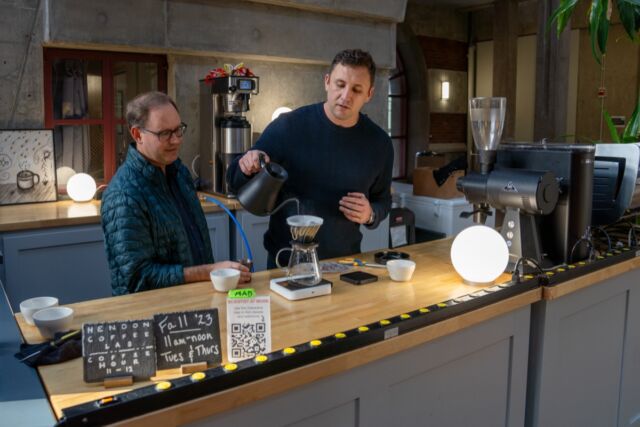Researchers display how adding a splash of water reduces static electricity when grinding coffee. Credit: University of Oregon
Scientific inspiration can strike at any time. For Christopher Hendon, a computational materials chemist at the University of Oregon, inspiration struck at a local coffee bar where his lab holds regular coffee hours for the Eugene campus community—a fitting venue since Hendon’s research specialties include investigating the scientific principles behind really good coffee. The regulars included two volcanologists, Josef Dufek and Joshua Méndez Harper, who noted striking similarities between the science of coffee and plumes of volcanic ash, magma, and water. Thus, an unusual collaboration was born.
“It’s sort of appreciate the start of a joke—a volcanologist and a coffee expert walk into a bar and then come out with a paper,” said Méndez Harper, a volcanologist at Portland State University. “But I think there are a lot more opportunities for this sort of collaboration, and there’s a lot more to know about how coffee breaks, how it flows as particles, and how it interacts with water. These investigations may help settle parallel issues in geophysics—whether it’s landslides, volcanic eruptions, or how water percolates through soil.”
The result is a new paper published in the journal Matter demonstrating how adding a single squirt of water to coffee beans before grinding can significantly reduce the static electric charge on the resulting grounds. This, in turn, reduces clumping during brewing, yielding less waste and the strong, consistent flow needed to produce a tasty cup of espresso. Good baristas already use the water trick; it’s known as the Ross droplet technique, per Hendon. But this is the first time scientists have rigorously tested that well-known hack and measured the actual charge on different types of coffee.
As previously reported, there’s actually an official industry standard for brewing espresso, courtesy of the Specialty Coffee Association, which sets out strict guidelines for its final volume (25-35 mL, or roughly one ounce) and preparation. The water must be heated to 92° to 95°C (197° to 203°F) and forced (at a specific pressure) through a bed of 7 to 9 grams (about a quarter of an ounce) of finely ground coffee for 20 to 30 seconds. But most coffee shops don’t follow this closely, typically using more coffee, while the brewing machines allow baristas to configure water pressure, temperature, and other key variables to their liking. The result of all those variations in technique is a great deal of variability in quality and taste.
In 2020, Hendon’s lab helped devise a mathematical model for brewing the perfect cup of espresso, over and over, while minimizing waste. The flavors in espresso derive from roughly 2,000 different compounds that are extracted from the coffee grounds during brewing.
So Hendon and his colleagues focused on building a mathematical model for a more easily measurable property known as the extraction yield (EY): the fraction of coffee that dissolves into the final beverage. That, in turn, depends on controlling water flow and pressure as the liquid percolates through the coffee grounds. Hendon et al. based their model on how lithium ions propagate through a battery’s electrodes, which they liken to how caffeine molecules dissolve from coffee grounds.

University of Oregon
A bunch of simulations and several thousand experimental shots of espresso later, the authors concluded that the most reproducible thing you can do is use fewer coffee beans and opt for a coarser grind with a bit less water; brew time was largely irrelevant. Conventional wisdom holds that a fine grind is best since more surface area of the resulting tamped-down coffee bed is exposed to the hot water, thus boosting the extraction yield. But the group’s experiments revealed that if coffee is ground too finely, it can clog the coffee bed, thereby reducing extraction yield. It’s also a big factor in the variability in taste.
This latest research focused on why the microscopic clumps form in the first place, particularly at very fine grind levels. The culprit is static electricity arising from the fracturing and friction between the beans during grinding. Hendon thought reducing that static would be a good way to eradicate those clumps. The technical term is triboelectricity, which arises from the accumulation of opposite electric charges on the surfaces of two different materials due to contact with each other. (It should not be confused with triboluminescence, the emission of cold light when a material is subjected to physical deformation—the reason Wint-O-Green Life Savers emit blue sparks when crushed, visible in the dark.)
A similar charge build-up also occurs during volcanic eruptions. “During eruption, magma breaks up into lots of little particles that then come out of the volcano in this big plume, and during that whole process, those particles are rubbing against each other and charging up to the point of producing lightning,” said Méndez Harper. “In a simplistic way, it’s similar to grinding coffee, where you’re taking these beans and reducing them to fine powder.” Since the particle-scale physics that occurs in volcanic plumes is quite difficult to research in nature, collaborating with Hendon to research triboelectric effects in coffee provided a useful smaller-scale platform.

